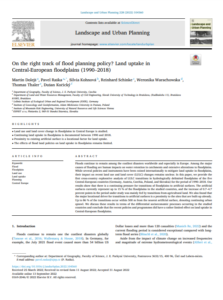Title: On the right track of flood planning policy? Land uptake in Central-European floodplains (1990–2018)
 Abstract: Floods continue to remain among the costliest disasters worldwide and especially in Europe. Among the major causes of flooding are human impacts on water retention in catchments and extensive alterations to floodplains. While several policies and instruments have been coined internationally to mitigate land uptake in floodplains, their impact on recent land use and land cover (LULC) changes remains unclear. In this paper, we provide the first cross-country explorative analysis of LULC transitions in hydrologically delimited floodplains of the five Central-European countries (Germany, Austria, Czechia, Poland, and Slovakia) for the period of 1990–2018. Our results show that there is a continuing pressure for transitions of floodplains to artificial surfaces. The artificial surfaces currently represent up to 15 % of the floodplains in the studied countries, and the increase of 0.7–4.7 percent points in the period under study was mainly fed by transitions from agricultural land. We also found that the major locational driver for transitions to artificial surfaces is a proximity to the sites that are built-up already. Up to 86 % of the transitions occur within 500 m from the nearest artificial surface, denoting continuing urban sprawl. We discuss these results in terms of the differential socioeconomic processes occurring in the studied countries and conclude that the recent policies and programmes did have a rather limited effect on land uptake in Central-European floodplains.
Abstract: Floods continue to remain among the costliest disasters worldwide and especially in Europe. Among the major causes of flooding are human impacts on water retention in catchments and extensive alterations to floodplains. While several policies and instruments have been coined internationally to mitigate land uptake in floodplains, their impact on recent land use and land cover (LULC) changes remains unclear. In this paper, we provide the first cross-country explorative analysis of LULC transitions in hydrologically delimited floodplains of the five Central-European countries (Germany, Austria, Czechia, Poland, and Slovakia) for the period of 1990–2018. Our results show that there is a continuing pressure for transitions of floodplains to artificial surfaces. The artificial surfaces currently represent up to 15 % of the floodplains in the studied countries, and the increase of 0.7–4.7 percent points in the period under study was mainly fed by transitions from agricultural land. We also found that the major locational driver for transitions to artificial surfaces is a proximity to the sites that are built-up already. Up to 86 % of the transitions occur within 500 m from the nearest artificial surface, denoting continuing urban sprawl. We discuss these results in terms of the differential socioeconomic processes occurring in the studied countries and conclude that the recent policies and programmes did have a rather limited effect on land uptake in Central-European floodplains.
Full citation: Dolejš, M., Raška, P., Kohnová, S., Schinke, R., Warachowska, W., Thaler, T., Kočický, D. (2022),On the right track of flood planning policy? Land uptake in Central-European floodplains (1990–2018). Landscape and Urban Planning, Volume 228,2022,104560,ISSN 0169-2046,https://doi.org/10.1016/j.landurbplan.2022.104560.
Full text available here.
